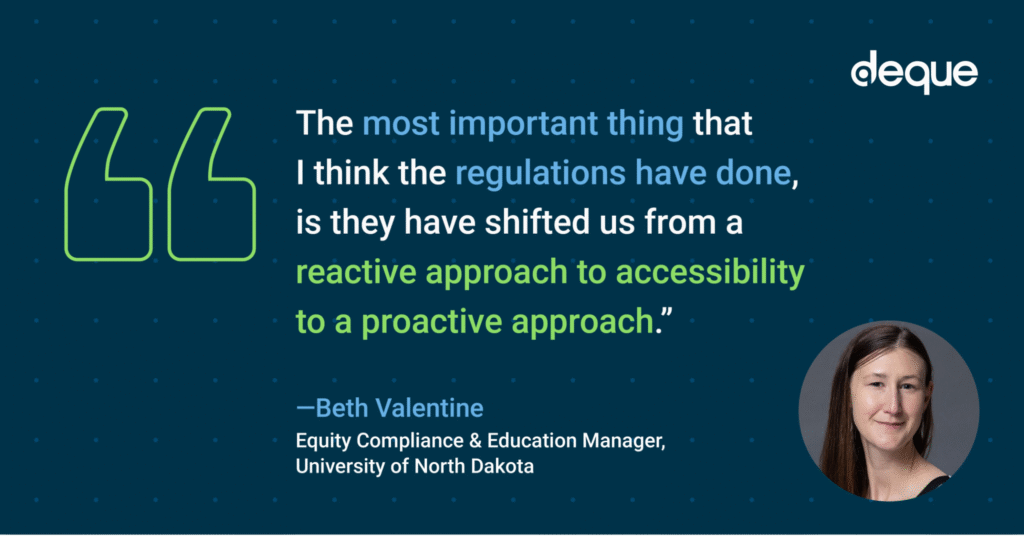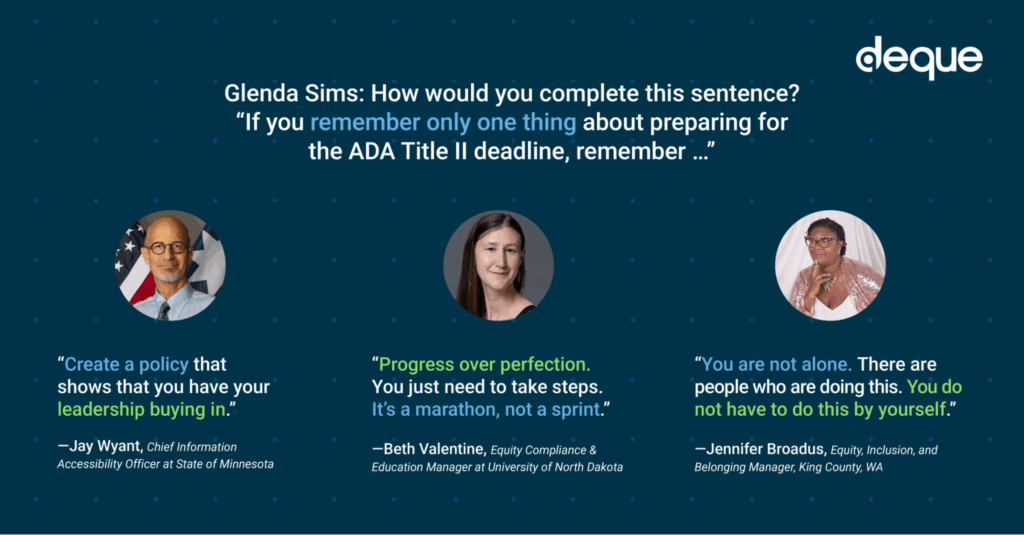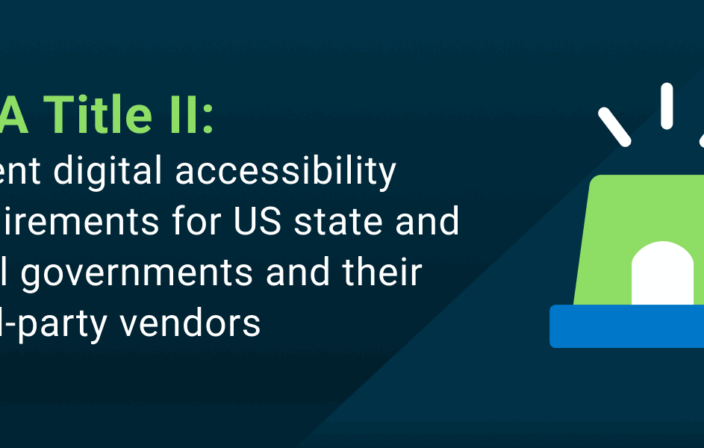Title II of the Americans with Disabilities Act (ADA) prohibits discrimination against individuals with disabilities by state and local governments, and the ADA Title II compliance clock is ticking. Do you have enough budget set aside? For large entities with populations of 50,000 or more, the deadline is less than nine months away.
Fortunately, even if your digital accessibility funding and processes are thin or missing altogether, you still have time to get started. However, every delay puts your organization at risk.
Under normal circumstances, establishing the foundation for compliance takes at least a year. You have to inventory every site and app, audit the riskiest workflows, set policy, train staff, and validate fixes. Skip any step, and you invite legal exposure and costly rework.
Complicating matters, 46 states have already locked their fiscal year 2026 budgets, so most new projects must fit inside funds that are already allocated.
But take heart! In this post, I’ll walk you through how to achieve compliance by the deadline. I’ll break down what you need to do, when you need to do it, and make clear why the best and least expensive time to start is right now.
Want to get started today? Schedule a free consultation with Deque!
ADA Title II compliance roadmap for SLED finance leaders
Every SLED (State and Local Government and Education) finance leader in the US needs to know how to make sure their organization is prepared for ADA Title II compliance.
Below is a do-right-now timeline that fits inside the time you have left before the April 24, 2026 deadline. (Smaller jurisdictions can follow the same steps, but with an extra year). This timeline lays out when to focus on each action and provides success metrics for completion. The timeline also highlights what you’ll need to budget for and how Deque can help accelerate your progress.
As you review, keep these factors in mind:
- You’re responsible for the compliance of third-party software that powers your public-facing digital interfaces. Secure updated VPATs and your third-party contract documentation now, so you’re not scrambling when audits begin next spring.
Note: You need to hold the vendors accountable without becoming their fix-it team. Continue running verification scans and require fresh VPATs or accessibility roadmaps. However, push every defect back to the vendor for remediation and retest before go-live. Your job is to verify and enforce the contract, not to spend public dollars cleaning up code you don’t own.
- Internally developed software is not exempt. Embed WCAG 2.1 AA checks in design reviews and CI pipelines today, so you can spend next year’s budget on new features instead of emergency rework.
| When (countdown) | What success looks like | Where costs come in | How Deque enables and accelerates this step |
|---|---|---|---|
| NOW – 60 days (Aug – Sep 2025) |
Inventory and governance kickoff
Key metric(s):
|
|
|
| 60 – 120 days (Oct – Nov 2025): Parallel Track 1 (These actions can take place concurrently with those in Parallel Track 2 below.) |
Rapid gap analysis and risk scoring
Key metric(s):
|
|
|
| 60 – 120 days (Oct – Nov 2025): Parallel Track 2 (These actions can take place concurrently with those in Parallel Track 1 above.) |
Policy and procurement lock-in
Key metric(s):
|
|
|
| 120 – 300 days (Dec – Mar 2025): Parallel Track 3 (These actions can take place concurrently with those in Parallel Track 4 below.) |
Training, tooling, release-gate rollout
Key metric(s):
|
|
|
| 120 – 300 days (Dec – Mar 2025): Parallel Track 4 (These actions can take place concurrently with those in Parallel Track 3 above.) |
Bridge-year action: Internal fixes and vendor compliance push
Key metric(s):
|
|
|
| By Deadline
April 24, 2026 |
Compliance check, public report
Key metric(s):
|
|
|
To start implementing these steps, schedule a free consultation with Deque today.
How to get the budget you need for ADA Title II
You now have a clear timeline with tasks and success metrics. You also have guidance around where to budget and recommendations on how Deque can accelerate your efforts.
Let’s now look at two different budget approaches you can present to your finance team today.
The “use it or lose it” request
The idea with this approach is to take advantage of any leftover dollars from the 2026 fiscal year budget. Here are the steps we recommend:
- Identify the pot. Check unspent SLFRF revenue-loss funds or other contingency accounts that must be spent by 2026.
- Spell out quick wins. Track the number of issues prevented from hitting production and demonstrate the ROI of a proactive approach. The cost of fixing bugs after they hit production is 30x higher. Example: 50 issues fixed early, at a cost of $637.50 per issue, is $31k saved. Looking to calculate this for yourself? Try the Deque ROI calculator.
- Show cost avoidance. A single ADA settlement can run from $10k to more than $50k—and that’s just the one-time cash payment made to the plaintiff. On top of that, the full cost of administrative work (including processing, internal and external legal counsel, and more) averages around $350k. The takeaway? Spending a smaller amount now prevents emergency transfers later.
- Make the ask. Request approval for a mid-year budget transfer from the revenue-loss or contingency fund so you can launch inventory, audit, and tooling this quarter.
The “penny on the dollar” request
Here, you’re focusing on the 2027 fiscal year, and you’re making the business case for being proactive about digital accessibility and fixing issues now while it’s still easy and inexpensive to do so, as opposed to paying later for costly and time-consuming rework. Here are the steps for this approach:
- Lead with the ratio. DOJ data says the average entity will spend about 2% of its annual revenue on Title II compliance.
- Translate benefits. Every dollar spent on accessibility returns more than $1.50 in time savings, lower call-center volume, and better consumer outcomes.
- Frame it as insurance. A recurring line for monitoring, training, and vendor VPAT checks prevents costly emergencies and reputational damage.
- Package the paperwork.
- One-page ROI sheet showing a $500k project and contrasting $25k in annual spend versus roughly $250k in deferred fixes and legal risk.
- Deque case study showing how accessibility costs drop from 15% to 5% of project budgets when testing starts early.
- Make the ask. Request approval to create a dedicated Digital Accessibility Compliance line at 10-13% of funds budgeted for IT or budgeted for content, starting in FY 2027, to cover monitoring, refresher training, and vendor verification.
Provide these two concise requests in a memo or slide deck. Keep the focus on the deadline, the small relative cost, and the large avoided risk, and budget officers will have clear reasons to approve both.
Act now or spend a lot more later
Proactive digital accessibility will save your organization money. We refer to this proactive approach as “shifting left”—moving digital accessibility earlier in the development process and addressing issues before they reach QA, or, even worse, production.

Deque’s shift-left research shows clear savings. When accessibility testing doesn’t happen until final QA, it eats roughly 20% of a project’s budget. On a $500k web refresh, that’s about $75k—and that’s before you tack on the extra developer hours and stakeholder churn that come with late fixes!
Move those checks into design reviews, pre-commit automation, and CI pipelines, and the accessibility slice drops to around 5%, or about $25k. We are even seeing organizations get down to 3% as their accessibility programs mature. In practical terms, catching accessibility issues early avoids $50k in direct project costs and shields another $200k from potential litigation and emergency remediation.
The pattern mirrors long-standing software-quality research. Defects found after release can cost up to 100 times more to fix than those caught during requirements or design. Every color-contrast miss spotted in Figma, every markup error flagged by axe DevTools before a merge, is dollars you never have to request in a last-minute “critical fix” budget. Early testing turns what could become a budget-buster into a predictable, easily justified line item.
Get funded and get compliant
The April 24, 2026, deadline is looming, and every month of delay raises your price tag and your risk. To ensure your organization gets compliant by the deadline, start with the money already on the table, line up next year’s recurring dollars, and let quick wins prove the return on investment along the way.
Remember, early action is the key to getting ahead of this deadline. Get strategic guidance on putting a plan in place by scheduling a free consultation with our experts, who’ve helped grow some of the world’s largest digital accessibility programs. We’re here to help!





